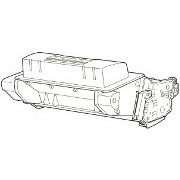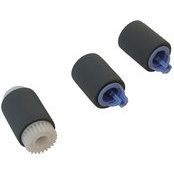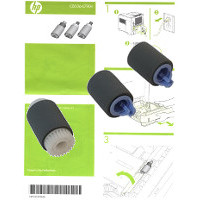HP Original Cartridges
Tray 2 Feed Rollers
The following kit is the official HP product. Almost no-one lists it because the price is laughable and confuses things. It uses the official Q7829-67925 rollers (?) but has little merit other than instuctions.
Reliable Remanufactured Cartridges
One of the merits of the P4014 against a new printer is the low cost of good re-manufactured cartridges.
At the moment we don't sell in the US, but we hope to soon
HP CB506-67904 Paper Feed Kit for P4014 Series Printers Cassette Tray 2.
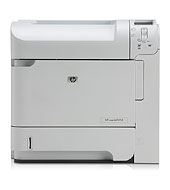
HP produce the CB506-67904 to fix paper feed problems from Tray two of P4014, P4015, P4515 printers and the related M4555 multifunction machine. The same kit is also used for the LaserJet Enterprise 600 M601, M602 and M603 machines which are strongly related and use many of the same parts.
Tray 2 is the cassette tray (pull-out tray). It pulls out from the lower front of the printer. Paper can range from 60-120gsm (tray 1 can handle 200 gsm).
It is normal to replace all three rollers at the same time. This isn't strictly necessary, the separation and feed rollers are likely to wear somewhat more than the pickup roller. Paper feed problems are often a bit erratic, however, and analysing which roller is the cause of a problem can take some time. Given the price of a kit compared with the cost of analysis most people will replace all the rollers.
HP maintenance kits CB389Adon't include the pickup roller
We could drop the pickup roller from our own paper feed kits and lower the price a bit. However our kit is already very competitive on cost for one using original parts. It is also necessary to change the roller from time to time, and most people are likely to prefer to have the part in the kit.
A fuller page on the roller kit is here
There is more on paper-feed problems here .
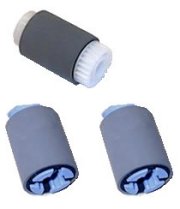
The counterpart for Tray 1 - the multi-purpose tray built in to the front of the printer is CB506-67905 .
The CB506-67904 kit contains 3 rollers:
- 1 x RM1-0036 Tray 2 Pickup Roller
- 2 x RM1-0037 Tray 2 Feed and Separation Roller
Feed and separation rollers are identical which makes some sense given the work they do.
The pickup roller RM1-0036pushes the paper forward in the tray and that is all. So if the pickup process can be heard operating but if paper scarcely moves it might be to blame. Other potential problems are the paper lifter drive RM1-4585 .
The feed roller RM1-0037takes over and pushes paper up from the tray and into the throat of the printer. Another set of feed rollers takes over. These rollers inside the printer (RM1-4527) use a hard rubber and are less prone to wear. Paper is straightened ready for print by the registration shutter RM1-5461 .
Feed and separation rollers are a bit prone to wear because they work against one another. The feed roller attempts to push the paper into the paper feed path but the separation roller underneath is driven by a cog on the side of the tray and is attempting to rotate the other way - pushing sheets back to the tray. The two rollers are working against one another so they will be rather inclined to wear out. Or at least, that is what happens if only one sheet feeds. However paper is a bit inclined to be sticky or ill-cut and sometimes two or more sheets move at the same time. When that happens the separation roller will get it's way and push those extra sheets back into the the tray until they are on top on the next feed. The separation roller is slightly weaker than the feed roller because it is driven through a torque limiter.
Brief Instructions
All three rollers simply clip onto their shafts.
Take the cassette (tray-2) entirely out of the printer. The separation roller is towards the front of the cassette, at the leading edge of the paper stack. The roller can be seen but it's shaft is behind a flap that folds down. With the flap out of the way the clip that holds the roller in place on the shaft can be seen. Unclip the roller and it slides off. The black object beside the roller is the torque limiter, the shaft drives the roller using it. A new roller just slides onto the shaft until it clips in place. The flap will then close.
It may be worth doing the tray first because it is easy to see how the roller clips onto the shaft.
The other two rollers are in the printer just above the front middle of the cassette. The one at the front is the feed roller (RM1-0037) and is identical to that in the cassette. The roller at the back is the pickup roller (RM1-0036). Both are really easy to change.
It is quite difficult to get the job wrong as the rollers will only click into place when they are correct.
In the unlikely event that changing the rollers doesn't fix feed problems here is a brief checklist.
- Don't overfill the tray. Trays take 500 sheets of paper about 80gsm thick. That doesn't mean there is a firm guarantee that you can empty a ream of paper into the tray and have it work properly. Some printers have 550 sheet trays and that avoids the problem, but these don't.
- Adjust the paper guides close to the paper but not to the point where they grip it firmly.
- Try turning the paper over and the other way round. Paper has a grain direction and is sometimes guillotined so that the edges fold slightly.
- Suspect an obstruction. Take the cassette, cartridge and if necessary the fuser out and examine the paper path for obstructions - staples, labels, human hair and other foreign objects.
There is more on paper-feed problems here .
Copyright G & J Huskinson & MindMachine Associates Ltd 2013, 2015. Some pictures derived from HP User and Service guides. These technical pages do not constitute an offer for sale; just our knowledge at the time of writing. See the catalogue. Sales pages on this Web site use cookies to store user information. We also use Google Analytics to track site usage patterns.

